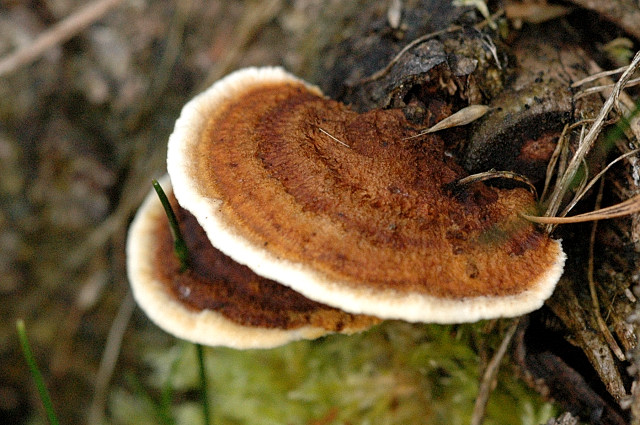- Gloeophyllum
Taxobox | name = "Gloeophyllum"

image_width = 225px
image_caption = Fruiting bodies of the rusty gilled polypore ("Gloeophyllum sepiarium")
regnum =Fungi
subregnum =Dikarya
phylum =Basidiomycota
subphylum =Agaricomycotina
classis =Agaricomycetes
ordo =Gloeophyllales
familia =Gloeophyllaceae
genus = "Gloeophyllum"
subdivision_ranks = Species
subdivision = "G. abietinum"
"G. carbonarium"
"G. mexicanum"
"G. odoratum"
"G. protractum"
"G. sepiarium"
"G. striatum"
"G. trabeum"Gloeophyllum genus characterized by the production of leathery to corky tough, brown, shaggy-topped, revivable fruitbodies lacking a stipe and with a lamellate to daedaleoid or poroid fertile under surface. The hyphal system is dimitic to trimitic. The genus is further characterized by the production of a brown rot of wood [cite journal | author=Gilbertson, R.L.|year=1981| title=North American wood-rotting fungi that cause brown rots| journal=Mycotaxon| volume=12| pages=372–416] [cite journal | author=Hibbett, D.S. & Donoghue, M.J.|year=2001| title=Analysis of character correlations among wood decay mechanisms, mating systems, and substrate ranges in Homobasidiomycetes|journal=Syst. Biol.| volume=50| pages=215–242| doi=10.1080/10635150151125879] . Phylogenetically, it along with several other brown rot
Basidiomycota , "Neolentinus ", "Heliocybe ", and "Veluticeps " form an order called theGloeophyllales [cite journal | author=Hibbett, D.S. et al.|year=2007| title=A higher-level phylogenetic classification of the Fungi| journal=Mycol. Res.| volume=111| pages=509–547| doi=10.1016/j.mycres.2007.03.004] cite journal | author=Hibbett, D.S. & Binder, M.|year=2002| title=Evolution of complex fruiting-body morphologies in homobasidiomycetes|journal=Proc. R. Soc. Lond. B| volume=269| pages=1963–1969| doi=10.1098/rspb.2002.2123] cite journal | author=Binder, M. et al.|year=2005| title=The phylogenetic distribution of resupinate forms across the major clades of mushroom-forming fungi (Homobasidiomycetes)|journal=Syst. Biodivers.| volume=3| pages=113–157| doi=10.1017/S1477200005001623] .The most frequently encountered species in the
Northern Hemisphere is "Gloeophyllum sepiarium " [http://www.uoguelph.ca/~gbarron/MISC2004/gloeophy.htm] , which is commonly found in a dried state on bothbark -covered and decorticated conifer stumps and logs, timbers onwharf s, planks on unpainted wooden buildings, wood bridges, and even creosotedrailroad tie s.Etymology The name Gloeophyllum combines "gloeo-" a reference to anything sticky, and "-phyllum", a reference to the lamellae. It is probably a combined reference to the fact the lamellae in the type species, "G. sepiarium", and other original species, appeared to be stuck together forming anastomosing bridges, to the point of forming a daedaleoid pattern. There is nothing sticky about the actual fungal fruitbodies. The name was originally spelled "Gleophyllum" but was soon changed and the current spelling is sanctioned.
References
Wikimedia Foundation. 2010.
